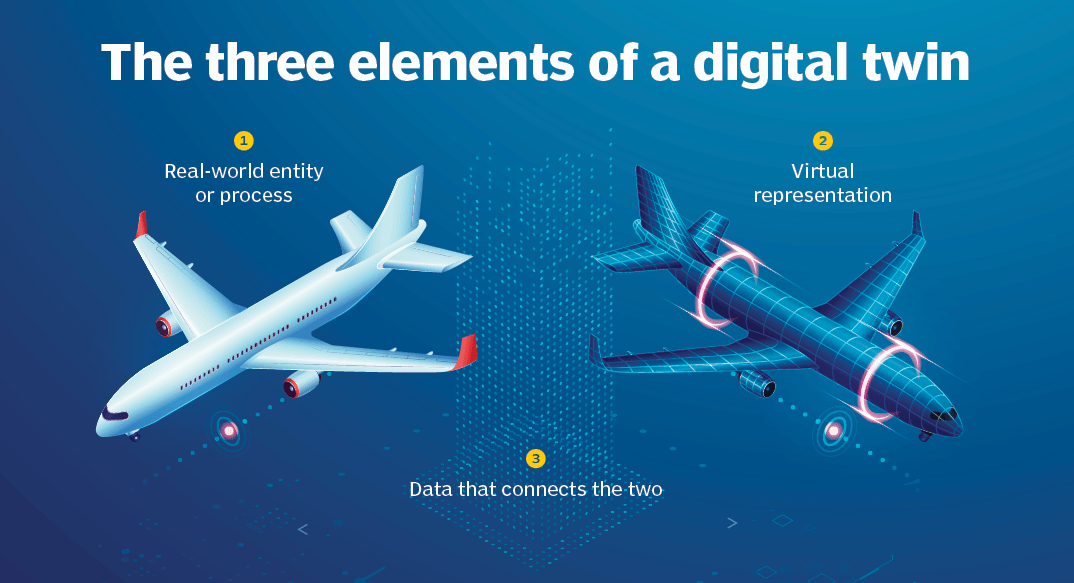In today’s rapidly evolving technological landscape, the concept of Digital Twins has emerged as a revolutionary force, driving innovation across various industries. These digital replicas of physical objects or systems have transcended their roots in manufacturing, finding applications in diverse sectors. In this blog, we’ll explore the intricacies of Digital Twins, from their definition to their integration into business workflows, and delve into the challenges and promising industry use cases.
1. What are Digital Twins?
Digital Twins represent a virtual counterpart of a physical entity, be it a machine, a product, or an entire system. This dynamic digital representation mimics the real-world entity’s behavior, capturing both its static and dynamic characteristics. Essentially, a Digital Twin serves as a bridge between the physical and digital realms, offering real-time insights into the status, performance, and behavior of the corresponding physical object.
Technical Aspects:
- Data Modeling: A detailed representation involving 3D models, sensor data, and historical information.
- Real-time Connectivity: Integration with sensors and IoT devices for continuous data synchronization.
- Simulation Techniques: Utilization of advanced simulations, such as Finite Element Analysis (FEA) and Computational Fluid Dynamics (CFD).
2. Where do we need them?
Digital Twins find applications across diverse industries, providing invaluable insights and driving innovation. Their relevance extends to:
Manufacturing:
- Design and Prototyping: Enhancing the product development lifecycle through virtual simulations.
- Production Optimization: Improving manufacturing efficiency by analyzing real-time data.
Healthcare:
- Patient-specific Modeling: Creating digital replicas of organs for personalized medical treatment.
- Predictive Healthcare: Anticipating and preventing health issues through real-time monitoring.
Infrastructure:
- Smart Cities: Enhancing urban planning by creating digital replicas of entire cityscapes.
- Building Management: Optimizing energy consumption and maintenance of structures.
3. The Process to Make Digital Twins
Creating a Digital Twin involves a meticulous process, combining data modeling, connectivity, and simulation techniques:
Data Modeling:
- Identify Key Data Points: Determine the essential parameters to be captured in the Digital Twin.
- 3D Modeling: Develop a detailed virtual representation of the physical entity.
Connectivity:
- Sensor Integration: Connect IoT devices and sensors to gather real-time data.
- Data Acquisition: Implement protocols like OPC UA and MQTT for efficient data transfer.
Simulation:
- Dynamic Data Updates: Continuously synchronize real-world data with the virtual model.
- Advanced Simulations: Employ FEA and CFD for accurate performance predictions.
4. Integrating Digital Twins in Business Workflows
The integration of Digital Twins into business workflows marks a paradigm shift in how organizations operate:
Manufacturing Workflow:
- Design Iterations: Iterate product designs virtually to reduce physical prototypes.
- Quality Control: Monitor production processes in real-time to ensure product quality.
Healthcare Workflow:
- Treatment Planning: Create patient-specific Digital Twins for precise medical interventions.
- Remote Monitoring: Continuously monitor patients’ health remotely through connected devices.
Infrastructure Workflow:
- Predictive Maintenance: Anticipate and address maintenance needs before failures occur.
- Urban Planning: Simulate and optimize city infrastructures for sustainability and efficiency.
5. Challenges Ahead
While the potential of Digital Twins is immense, challenges exist on the path to widespread adoption:
Security and Privacy:
- Cybersecurity Measures: Implement robust security protocols to protect sensitive data.
- Data Privacy Concerns: Address concerns related to the collection and usage of personal or proprietary information.
Scalability:
- Handling Large Datasets: Develop scalable architectures to handle vast amounts of data.
- Distributed Systems: Implement distributed systems for efficient data processing.
Industry Standardization:
- Interoperability: Establish industry-wide standards to ensure interoperability between different Digital Twin platforms.
- Regulatory Compliance: Navigate and comply with evolving regulations related to Digital Twin technologies.
6. Industry Use Case
One exemplary use case that showcases the transformative power of Digital Twins is within the Aerospace industry:
Aerospace: Digital Twins for Aircraft Maintenance
Aircraft maintenance is a critical aspect of aviation safety and efficiency. By creating Digital Twins of aircraft, airlines can:
- Predictive Maintenance: Anticipate component failures based on real-time data, minimizing downtime.
- Performance Optimization: Monitor and optimize fuel efficiency, reducing operational costs.
- Virtual Training: Provide realistic training scenarios for maintenance personnel.
This use case exemplifies how Digital Twins can revolutionize traditional maintenance processes, ensuring safer and more efficient operations in the aerospace sector.
Conclusion
Digital Twins have transcended their origins, evolving into a transformative force with the potential to revolutionize industries. As organizations embrace this technology, they unlock unprecedented insights into their operations, driving innovation, and ensuring a competitive edge in the digital era. While challenges persist, the promise of Digital Twins heralds a future where the physical and digital worlds seamlessly converge, ushering in an era of unparalleled efficiency and innovation.

